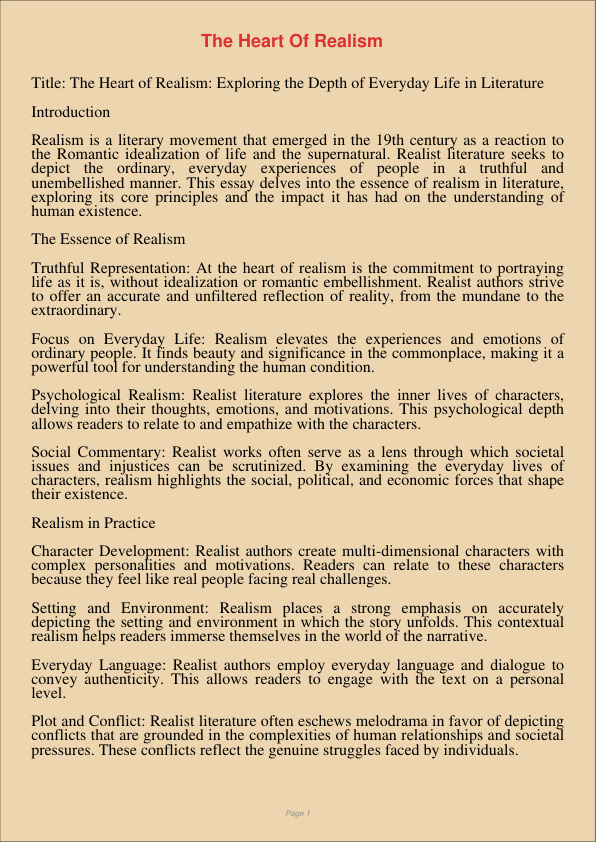The Heart Of Realism
Dec 31, 2023
realism
heart
History
Nursing

Title: The Heart of Realism: Exploring the Depth of Everyday Life in Literature
Introduction
Realism is a literary movement that emerged in the 19th century as a reaction to the Romantic idealization of life and the supernatural. Realist literature seeks to depict the ordinary, everyday experiences of people in a truthful and unembellished manner. This essay delves into the essence of realism in literature, exploring its core principles and the impact it has had on the understanding of human existence.
The Essence of Realism
Truthful Representation: At the heart of realism is the commitment to portraying life as it is, without idealization or romantic embellishment. Realist authors strive to offer an accurate and unfiltered reflection of reality, from the mundane to the extraordinary.
Focus on Everyday Life: Realism elevates the experiences and emotions of ordinary people. It finds beauty and significance in the commonplace, making it a powerful tool for understanding the human condition.
Psychological Realism: Realist literature explores the inner lives of characters, delving into their thoughts, emotions, and motivations. This psychological depth allows readers to relate to and empathize with the characters.
Social Commentary: Realist works often serve as a lens through which societal issues and injustices can be scrutinized. By examining the everyday lives of characters, realism highlights the social, political, and economic forces that shape their existence.
Realism in Practice
Character Development: Realist authors create multi-dimensional characters with complex personalities and motivations. Readers can relate to these characters because they feel like real people facing real challenges.
Setting and Environment: Realism places a strong emphasis on accurately depicting the setting and environment in which the story unfolds. This contextual realism helps readers immerse themselves in the world of the narrative.
Everyday Language: Realist authors employ everyday language and dialogue to convey authenticity. This allows readers to engage with the text on a personal level.
Plot and Conflict: Realist literature often eschews melodrama in favor of depicting conflicts that are grounded in the complexities of human relationships and societal pressures. These conflicts reflect the genuine struggles faced by individuals.
Realism and Its Impact
An Understanding of Human Nature: Realism fosters a deeper understanding of the human experience by portraying the multifaceted nature of human behavior, relationships, and emotions. It encourages readers to examine their own lives and reflect on the lives of others.
Social Critique: Realist literature has been instrumental in critiquing and challenging societal norms and inequalities. By portraying the realities of social injustice and the human consequences of those injustices, realist works have prompted social change.
Influence on Other Art Forms: Realism has not been limited to literature. It has influenced visual arts, theater, and film, where the everyday lives of individuals are depicted with similar attention to detail and authenticity.
Conclusion
Realism, as a literary movement, allows us to explore the heart of everyday life. It unveils the complexities of the human experience and exposes the underlying truths that define our existence. Realist literature offers a mirror to society, reflecting our shared struggles, dreams, and aspirations. It is through the lens of realism that we can better understand ourselves, our communities, and the world in which we live. In essence, realism is a testament to the profound beauty and significance found in the unadorned realities of life.